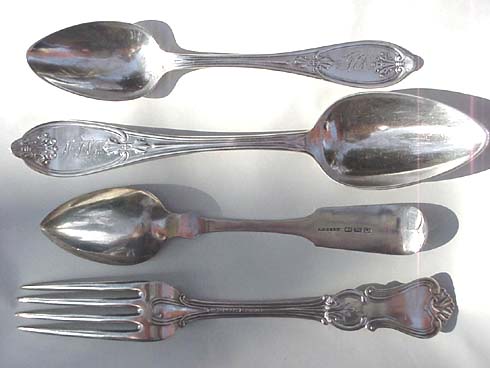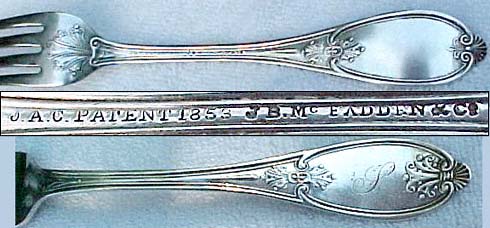|
A GLOSSARY of MILLED BANDS
|
|
| How to Post Photos |
REGISTER (click here)
|
|
A GLOSSARY of MILLED BANDS
|
|
| How to Post Photos |
REGISTER (click here)
|

|
 SMP Silver Salon Forums SMP Silver Salon Forums
  American Silver before sterling American Silver before sterling
  The pseudohallmarks of John A. Cole The pseudohallmarks of John A. Cole
|
| next newest topic | next oldest topic |
| Author | Topic: The pseudohallmarks of John A. Cole |
|
Brent Posts: 1507 |
  
  These pictures show a set of pseudo-hallmarks and an "Olive" type flatware pattern sporting those same marks. Research and good fortune have led me to conclude that the [Head][Lion][C] marks are the manufacturer's mark of John A. Cole of New York City. Here is my evidence. 1.) I have a set of forks in this same pattern with the words J.A.C. PATENT 1853. I once had a set of identical forks with the pseudo-hallmarks only. John A. Cole has the right initials, and was manufacturing coin silver at the right time. 2.) Belden's Marks of American Silversmiths in the Ineson-Bissel Collection illustrates a mark with John A. Cole's name and these same pseudohallmarks. Manufacturers like George Sharp are known to have sold silver marked in very much the same way. It isn't perfectly conclusive, but the evidence fits. Little has been published about John A. Cole, other than that he began working in New York City in the early 1840's and appears to have gone out of business by 1858. According to helpful people with access to the patent records, no flatware patents were granted in 1853. It is possible that the patent was withdrawn, or never granted in the first place; we may never know for certain. At any rate, I do believe that this pattern was Cole's. The front side of the pattern is similar to the back, with the addition of a very stylized pendant shell at the tip. For those of you with a copy of "Silver in the Golden State", this same pattern is illustrated under the name "Olive" and attributed to Frederick Reichel of California. I had an opportunity to handle two different california spoons in this pattern. One had the Cole marks, as well as the K&R stamp of Koehler & Ritter of San Francisco. The other spoon was noticeably lighter in weight and carried a California retailer mark only. My theory is that one of the California manufacturers, probably Reichel, produced copies of Cole's design, probably after Cole went out of business. The Koehler and Ritter marked spoon was probably old stock, as they succeeded Reichel in 1867. IP: Logged |
|
wev Moderator Posts: 4121 |
  
Interesting post in an area that deserves much greater attention. I would only offer a small note of caution for the benefit of new collectors. While a particular pseudo-hallmark might be positively associated with a certain maker at a certain time, generalizations need to be made with care. Such marks should always be judged in conjunction with the overall aspect of a piece and with any other marks present. I have, for example, a pair of place spoons with identical pseudohallmarks to those shown in the above post. They are, however, shoulderless with narrow square-cut fiddleback handles and applied spade drops and also carry the mark of the maker, Matthew Pettit (working New York City c 1800-1815). In this case, there is little danger of misidentification. Pettit, however, is known to have marked some items, particularly spoons in sets, with only the pseudo-marks and it is possible that an inexperienced collector could jump to the wrong conclusion entirely. A slightly ludicrous example perhaps, but I think the point worth making. IP: Logged |
|
Ted Posts: 17 |
  
Nice to know about John Cole. I have had a set of forks & tablespoons in this pattern and couldn't identify them. I do think that we should realize that these hallmarks are actually trade marks, and were the same all the time. As far as the patent date goes, he possibly applied in 1853 and was granted in 1854 or something as simple as that. I would guess that second California set was also made by Cole. My experience, in known patterns, is that they frequently are different weights. I also wonder about the expense and difficulty in producing a die. Ted Stickney IP: Logged |
|
Brent Posts: 1507 |
  
Wev, I would love to see the marks on the Pettit spoons for comparison; any chance of a post? I should have elaborated more on the patent information. From what I have learned, no patent exists for this pattern for any year. I have been told that all patents for "Olive" pattern variations were withdrawn, due to multiple patent infringement suits. If true, this may have been one of the patterns involved. I agree that the California spoons could well be from the same die as the others. I was thinking that perhaps the dies were sold and re-used after Cole's business went under. You are also right that weight can vary greatly within a pattern, and shouldn't be used to conclude that flatware was made by different makers. IP: Logged |
|
Brent Posts: 1507 |
  
 (Letter sent to me by Trefid):
quote: IP: Logged |
|
Brent Posts: 1507 |
  
 I just realized that I had never posted my own pictures on this topic, so here they are. I am certain that J.A.C. is indeed John A. Cole. McFadden was a prominent retailer in Pittsburgh, PA. Brent IP: Logged |
|
Barbara unregistered |
 
I have a fork with what looks like the same pseudos -- except that the first one is very blurred. And the fork is also literally marked John A. Coles. So I agree with you, Brent, that Coles used these pseudos. As to when and where he worked:
but somewhere she states that she did not go further back in the New York City directories than 1852. Von Khrum gives 1841-59. His locations are given as 4 Little Green Street and 8 Liberty Place, but this is the same location: Little Green Street's name was changed to "Liberty Place" during this period, and 4-8 Liberty Place was a single large building (or set of conjoined buildings) where a lot of silver firms were located. IP: Logged |
All times are ET | next newest topic | next oldest topic |
  |
|
Ultimate Bulletin Board 5.46a
|
1. Public Silver Forums (open Free membership) - anyone with a valid e-mail address may register. Once you have received your Silver Salon Forum password, and then if you abide by the Silver Salon Forum Guidelines, you may start a thread or post a reply in the New Members' Forum. New Members who show a continued willingness to participate, to completely read and abide by the Guidelines will be allowed to post to the Member Public Forums. 2. Private Silver Salon Forums (invitational or $ donation membership) - The Private Silver Salon Forums require registration and special authorization to view, search, start a thread or to post a reply. Special authorization can be obtained in one of several ways: by Invitation; Annual $ Donation; or via Special Limited Membership. For more details click here (under development). 3. Administrative/Special Private Forums (special membership required) - These forums are reserved for special subjects or administrative discussion. These forums are not open to the public and require special authorization to view or post. |
|
copyright © 1993 - 2022
SM Publications
All Rights Reserved. Legal & Privacy Notices |